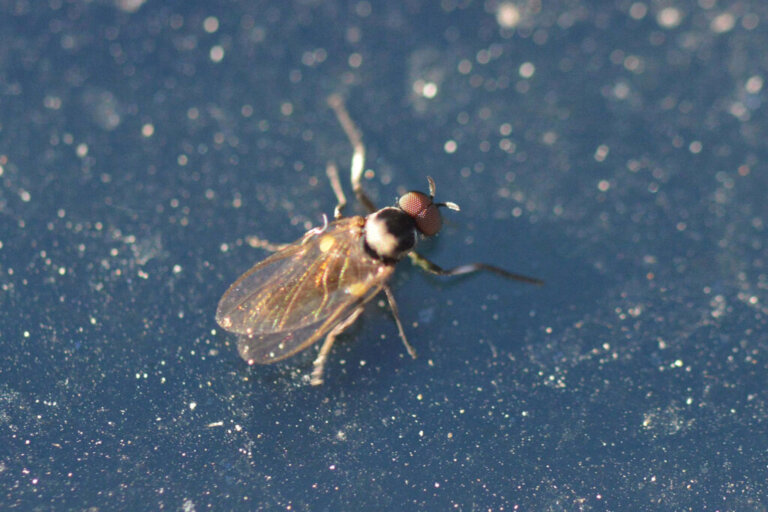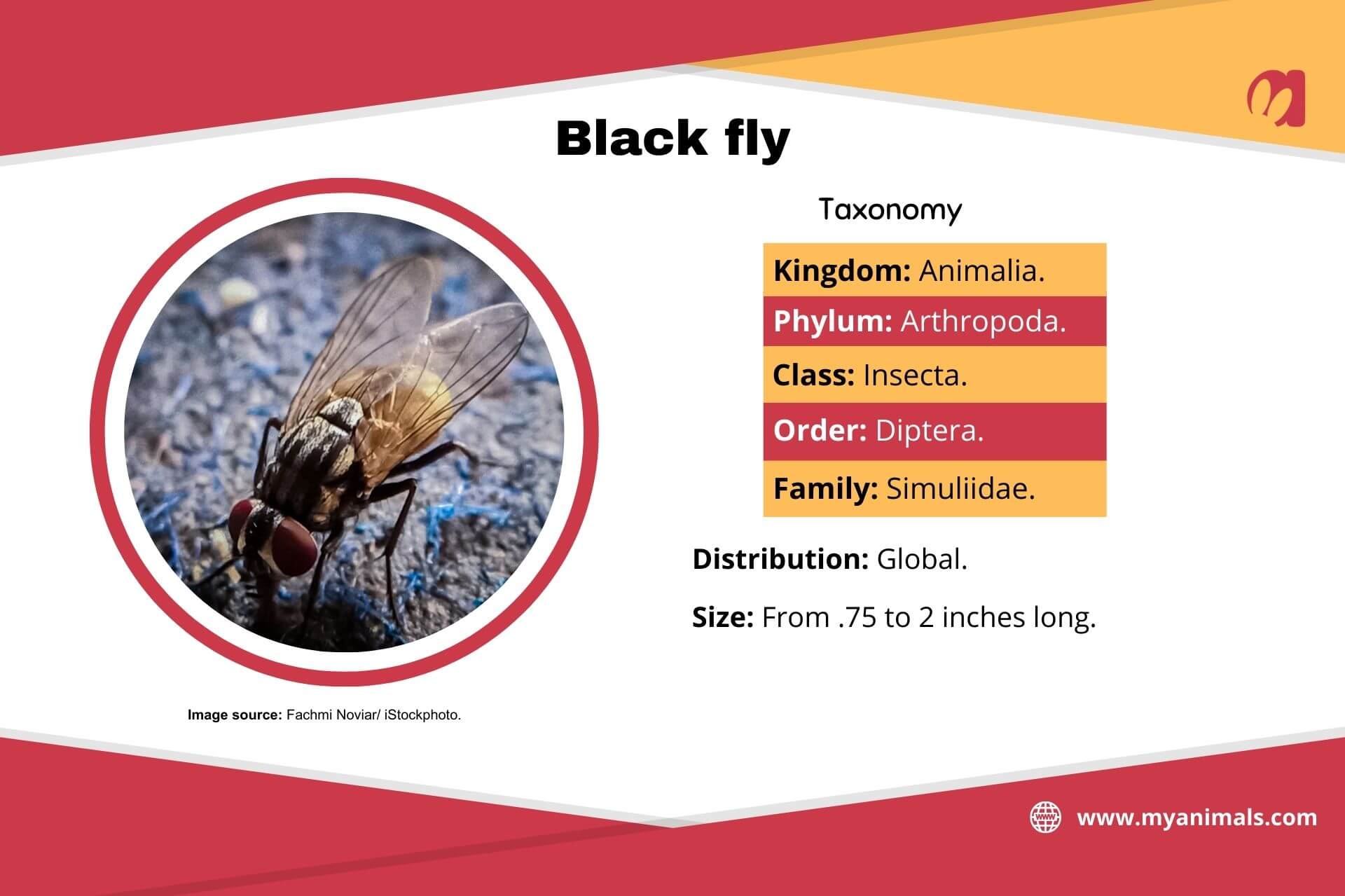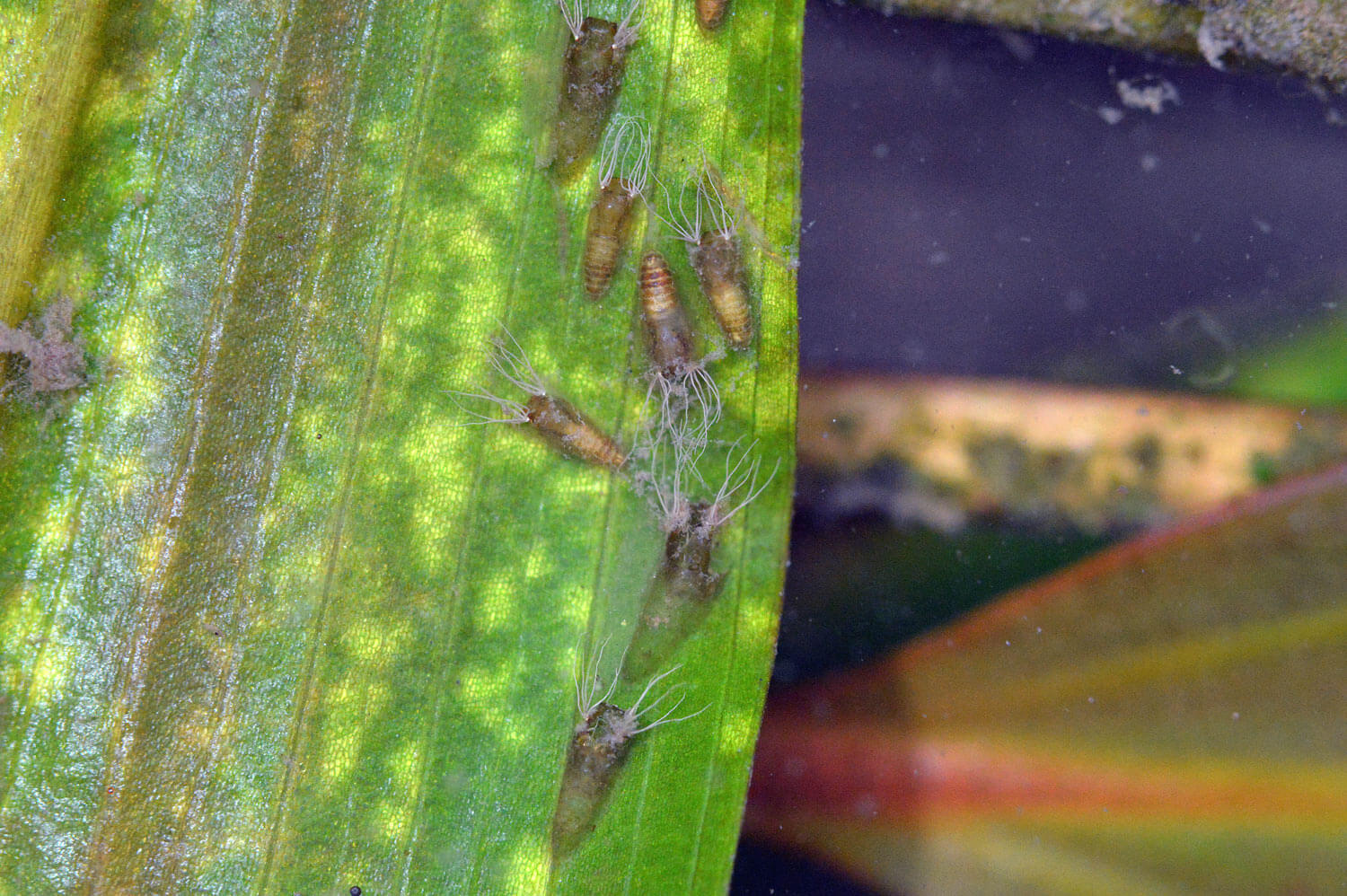The Black Fly: What Do You Need to Know and How to Protect Yourself?


Written and verified by the biologist Georgelin Espinoza Medina
The black fly or midge is an insect adapted to aquatic life, as its larval stage develops in water, while its adult stage takes place on land. This specimen is of importance due to the impact of its sting on humans and other animals. It’s annoying, painful, and can transmit diseases.
This fly belongs to the order Diptera and the family Simuliidae, which includes about 43 genera and 2,387 species. In this article, we’ll share with you a complete description of the characteristics and life cycle of this insect, as well as everything you should know about its bite and how to protect yourself from it.
Characteristics of the black fly

Gnats are characterized by their small size, measuring only .75 to 7 inches in length. In addition to their small size, they have a dark-colored body, which is why they’re commonly known as black flies. This insect is easy to distinguish by its morphology:
- A robust body
- A hemispherical head with compound eyes (without ocelli) and short antennae
- A thorax with a small curvature characteristic of this group and a cylindrical abdomen
- Large wings with simple venation
- Short and strong legs
Their distribution is cosmopolitan, and they feed on sugary vegetable juices. However, the females of most species need to ingest blood for the maturation process of their eggs, as occurs, similarly, in the case of mosquitoes.
Therefore, only females are hematophagous.
They tend to swarm together, especially at dawn or dusk. They can also travel long distances in search of their hosts (usually birds and mammals).
Life cycle of Simuliidae

The black fly is an insect that goes through a complete metamorphosis because it passes through different stages to complete its development:
- Egg
- Larva
- Pupa
- Adult or imago
Because of this type of life cycle, it’s known as a holometabolous insect.
The average number of eggs laid by these animals is 200 to 300 per reproductive cycle. These are laid in small groups, on the surface or under lotic or moving water, on vegetation, or in humid places. They have a sticky gelatinous covering that serves for adhesion.
The larvae are elongated and sedentary. They attach themselves to rocks or vegetation to avoid being carried away by currents, thanks to a suction cup in the caudal region. The pupa doesn’t feed. In other words, it’s aphagous.
It continues its development in the water, in a particular cocoon with a conical shape. Adults emerge in the water but quickly come to the surface to dry and begin their aerial life, unlike the rest of the stages, which are aquatic.
The complete duration of the cycle and of each particular phase varies in different species and according to environmental conditions.
The black fly bite
Most members of the family Simuliidae require blood ingestion for egg development. Their hosts include birds and mammals, including humans. The mandibles of these insects tear the skin and produce a wound so that blood can flow and be sucked out.
During this process, they inoculate different substances with their saliva, with the following properties:
- Anesthetic
- Analgesic
- Anticoagulant
- Vasodilators
Thus, there’s no pain or blood clotting. However, once the effect wears off, there’s pain and local inflammation in the area of the bite.
Likewise, an allergic reaction to the insect’s saliva and its components may occur. Sometimes, these responses tend to present complications, especially if the attacks are numerous. The bite often leads to secondary infections if the area isn’t properly treated.
What diseases does the black fly cause?
In addition to discomfort, pain, and allergic reactions, midges can function as vectors and transmit diseases, including onchocerciasis. This condition causes severe skin and eye lesions, which are caused by the filarial disease Onchocerca volvulus.
Black flies can also transmit other diseases to humans, including Ozzard’s filariasis or mansonellosis, which is caused by the pathogen Mansonella ozzardi in the Americas. It also serves as a vector to animals (livestock and poultry) for organisms such as the following:
- Nematodes
- Protozoa
- Viruses
How to protect yourself?
Unlike other diptera, such as mosquitoes, midges don’t usually enter buildings. However, in cases of abundant populations or if you live in regions bordering rivers or streams, you can choose to place mosquito nets on the doors and windows of your home.
Likewise, the Official College of Pharmacists of Zaragoza recommends implementing some measures to avoid gnat bites. These are the following:
- Use appropriate clothing and completely cover arms and legs: It’s advisable to wear long pants and shirts.
- Use insect repellents on the skin, being sure to follow the manufacturer’s instructions. Keep in mind that these products aren’t recommended for small children or children under two years of age.
- Try to avoid going outdoors in places with rivers or other fast-flowing watercourses and abundant vegetation, especially at dawn or dusk, when these insects are most active.
In case of bites, wash the affected area very well with soap and water and then apply an antiseptic. Don’t scratch, and keep in mind that in case of any sign of allergy, you should consult a doctor.
Follow recommendations
Despite its small size, the black fly is a dangerous insect, as it’s capable of transmitting diseases that affect humans and animals, its bite is painful, and, what’s more, there’s the possibility that the victims generate an allergic response.
Therefore, it’s better to follow the recommendations and avoid greater evils, especially if you’re in regions with conditions that are favorable for the development of these insects.
The black fly or midge is an insect adapted to aquatic life, as its larval stage develops in water, while its adult stage takes place on land. This specimen is of importance due to the impact of its sting on humans and other animals. It’s annoying, painful, and can transmit diseases.
This fly belongs to the order Diptera and the family Simuliidae, which includes about 43 genera and 2,387 species. In this article, we’ll share with you a complete description of the characteristics and life cycle of this insect, as well as everything you should know about its bite and how to protect yourself from it.
Characteristics of the black fly

Gnats are characterized by their small size, measuring only .75 to 7 inches in length. In addition to their small size, they have a dark-colored body, which is why they’re commonly known as black flies. This insect is easy to distinguish by its morphology:
- A robust body
- A hemispherical head with compound eyes (without ocelli) and short antennae
- A thorax with a small curvature characteristic of this group and a cylindrical abdomen
- Large wings with simple venation
- Short and strong legs
Their distribution is cosmopolitan, and they feed on sugary vegetable juices. However, the females of most species need to ingest blood for the maturation process of their eggs, as occurs, similarly, in the case of mosquitoes.
Therefore, only females are hematophagous.
They tend to swarm together, especially at dawn or dusk. They can also travel long distances in search of their hosts (usually birds and mammals).
Life cycle of Simuliidae

The black fly is an insect that goes through a complete metamorphosis because it passes through different stages to complete its development:
- Egg
- Larva
- Pupa
- Adult or imago
Because of this type of life cycle, it’s known as a holometabolous insect.
The average number of eggs laid by these animals is 200 to 300 per reproductive cycle. These are laid in small groups, on the surface or under lotic or moving water, on vegetation, or in humid places. They have a sticky gelatinous covering that serves for adhesion.
The larvae are elongated and sedentary. They attach themselves to rocks or vegetation to avoid being carried away by currents, thanks to a suction cup in the caudal region. The pupa doesn’t feed. In other words, it’s aphagous.
It continues its development in the water, in a particular cocoon with a conical shape. Adults emerge in the water but quickly come to the surface to dry and begin their aerial life, unlike the rest of the stages, which are aquatic.
The complete duration of the cycle and of each particular phase varies in different species and according to environmental conditions.
The black fly bite
Most members of the family Simuliidae require blood ingestion for egg development. Their hosts include birds and mammals, including humans. The mandibles of these insects tear the skin and produce a wound so that blood can flow and be sucked out.
During this process, they inoculate different substances with their saliva, with the following properties:
- Anesthetic
- Analgesic
- Anticoagulant
- Vasodilators
Thus, there’s no pain or blood clotting. However, once the effect wears off, there’s pain and local inflammation in the area of the bite.
Likewise, an allergic reaction to the insect’s saliva and its components may occur. Sometimes, these responses tend to present complications, especially if the attacks are numerous. The bite often leads to secondary infections if the area isn’t properly treated.
What diseases does the black fly cause?
In addition to discomfort, pain, and allergic reactions, midges can function as vectors and transmit diseases, including onchocerciasis. This condition causes severe skin and eye lesions, which are caused by the filarial disease Onchocerca volvulus.
Black flies can also transmit other diseases to humans, including Ozzard’s filariasis or mansonellosis, which is caused by the pathogen Mansonella ozzardi in the Americas. It also serves as a vector to animals (livestock and poultry) for organisms such as the following:
- Nematodes
- Protozoa
- Viruses
How to protect yourself?
Unlike other diptera, such as mosquitoes, midges don’t usually enter buildings. However, in cases of abundant populations or if you live in regions bordering rivers or streams, you can choose to place mosquito nets on the doors and windows of your home.
Likewise, the Official College of Pharmacists of Zaragoza recommends implementing some measures to avoid gnat bites. These are the following:
- Use appropriate clothing and completely cover arms and legs: It’s advisable to wear long pants and shirts.
- Use insect repellents on the skin, being sure to follow the manufacturer’s instructions. Keep in mind that these products aren’t recommended for small children or children under two years of age.
- Try to avoid going outdoors in places with rivers or other fast-flowing watercourses and abundant vegetation, especially at dawn or dusk, when these insects are most active.
In case of bites, wash the affected area very well with soap and water and then apply an antiseptic. Don’t scratch, and keep in mind that in case of any sign of allergy, you should consult a doctor.
Follow recommendations
Despite its small size, the black fly is a dangerous insect, as it’s capable of transmitting diseases that affect humans and animals, its bite is painful, and, what’s more, there’s the possibility that the victims generate an allergic response.
Therefore, it’s better to follow the recommendations and avoid greater evils, especially if you’re in regions with conditions that are favorable for the development of these insects.
All cited sources were thoroughly reviewed by our team to ensure their quality, reliability, currency, and validity. The bibliography of this article was considered reliable and of academic or scientific accuracy.
- Bueno, R., Timón, F., Almeida, P., Clemente, M., Serna, J., Acosta, R., & Jiménez, D. (2020). Primeros hallazgos de mosca negra (Diptera: Simuliidae) en el municipio de Sagunt (Valencia). Arquivos Entomolóxicos, 22, 293-298. https://dialnet.unirioja.es/servlet/articulo?codigo=7675365
- Colegio Oficial de Farmacéuticos de Zaragoza. (s.f.). Mosca negra: Los farmacéuticos recomiendan extremar las precauciones frente a las picaduras. Consultado el 18 de junio de 2023. https://cofzaragoza.org/mosca-negra/
- Domínguez-Quintanar, E., Castellanos-López, V., & Peña-Zarco, F. (2021). Oncocercosis. TEPEXI Boletín Científico De La Escuela Superior Tepeji Del Río, 8(16), 48-50. https://repository.uaeh.edu.mx/revistas/index.php/tepexi/article/view/6430
- Marie, C., & Petri, W. (2022). Mansonelosis. MSD Manual. Consultado el 18 de junio de 2023. https://www.msdmanuals.com/es-ve/professional/enfermedades-infecciosas/nematodos-gusanos-redondos/mansonelosis
- Ramos, S. (2020). La expansión de la mosca negra (Simuliium erytrocephalum) en España. Tesis de grado. Universidad de La Laguna. https://riull.ull.es/xmlui/handle/915/19995
- Sánchez-López, P., Ruiz-Arrondo, I., Kotter, H., Pacheco Martínez, F., Segovia Hernández, M., & Gómez, E. (2018). Nuevos retos en gestión de vectores en salud pública: la mosca negra en Murcia (España). Gaceta Sanitaria, 32(2), 181-183. https://scielo.isciii.es/scielo.php?script=sci_arttext&pid=S0213-91112018000200016
- Vitta P., N. (2017) Orden Diptera Familia Simuliidae. Santiago: Boletin INIA – Instituto de Investigaciones Agropecuarias. no. 344. Consultado el 26 de junio de 2023 https://hdl.handle.net/20.500.14001/6578
This text is provided for informational purposes only and does not replace consultation with a professional. If in doubt, consult your specialist.








